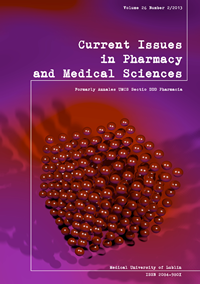Analysis of selected pro-inflammatory cytokines in patients with fracture of the proximal end of the femur
DOI:
https://doi.org/10.12923/j.2084-980X/26.2/a.01Słowa kluczowe:
fracture of the proximal end of the femur, IL-1, IL-6, osteoporosis, TNF-αAbstrakt
Fracture of the proximal end of the femur is one of the most common fractures in elderly patients. Worldwide, this type of fracture occurs in 2.5 m of people annually including approximately 30, 000 Poles. It usually occurs as a complication of osteoporosis. In the bones, changes in the level of cytokines following osteoporosis are observed. These changes refer mainly to pro-inflammatory cytokines: tumor necrosis factor α (TNF-α), interleukin 1 (IL-1) and interleukin 6 (IL-6). The aim of this preliminary study was to assess if there are any changes in the blood level of these cytokines in ostmenopausal patients with low-energy fracture of the proximal end of the femur. Additionally, the changes in cytokines concentration were also analyzed in conjunction with the body mass index, sex hormones (FSH and estradiol) as well as parameters connected with bone turnover (calcium, phosphorus). The study showed a significantly higher concentration of interleukin 1, interleukin 6 and TNF-α in patients with a low-energy fracture of the proximal end of the femur and confirmed the relationship between blood estradiol level and body mass index versus the tested fracture.
Bibliografia
1. Badurski J., Jeziernicka E., Dobreńko A. et al.: Charakterystyka złamań osteoporotycznych regionu białostockiego (B0S-2). Zastosowanie algorytmu WHO i narzędzi FRAX®BMI i FRAX®BMD do identyfikacji osób wymagających leczenia. Endokrynologia Polska, 62, 290, 2011.
2. Braun T., Zwerina J.: Positive regulators of osteoclastogenesis and bone resorption in rheumatoid arthritis. Arthritis Res Ther., 13, 235, 2011.
3. Felsenberg D., Boonen S.: The bone quality framework: determinants of bone strength and their interrelationships, and implications for osteoporosis management. Clin Ther., 27, 1, 2005.
4. Giannakoulas N.C., Terpos E., Palassopoulou M. et al.: Increased RANKL and IL-6 levels might result in high bone turnover in a case of a CD34+/CD117+/myeloperoxidase (+dim) acute myeloid leukemia presenting with severe hypercalcemia and lumbar spine fractures. Leuk Res., 35, 188, 2011.
5. Guła Z., Korkosz M.: Osteoporoza w wieku podeszłym - patogeneza, ocena ryzyka złamań i skuteczność przeciwzłamaniowa leków. Gerontologia Polska, 18, 1-7, 2010.
6. Keen R.: Osteoporosis: strategies for prevention and management. Best Pract Res Clin Rheumatol., 21, 109, 2007.
7. Krämer H.H., Eberle T., Uçeyler N. et al.: TNF-alfa in CRPS and 'normal' trauma-significant differences between tissue and serum. Pain, 152, 285, 2011.
8. Lacativa P.G., Farias M.L.: Osteoporosis and inflammation. Arq Bras Endocrinol Metabol., 54, 123, 2010.
9. Męczekalski B., Czyżyk A.: Konwencjonalna hormonalna terapia zastępcza w leczeniu osteoporozy. Pol. Merk. Lek., 27, 72, 2009.
10. Myśliwiec J., Adamczyk M., Nikolajuk A., Górska M.: Interleukina 6 i jej istotna rola w patogenezie zaburzeń obrotu kostnego w przebiegu tyreotoksykozy u kobiet po menopauzie. Endokrynologia Polska, 62, 299, 2011.
11. Myśliwiec J., Zbucki R., Nikolajuk A. et al.: Estrogens modulate RANKL-RANK//osteoprotegerin mediated Interleukin-6 effect on thyrotoxicosis-relatedbone turnover in mice. Horm Metab Res., 43, 236, 2011.
12. O’Brien C.A., Jilka R.L., Fu Q. et al.: IL-6 is not required for parathyroid hormone stimulation of RANKL expression, osteoclast formation, and bone loss in mice. Am J Physiol Endocrinol Metab., 289, 784, 2005.
13. Roszkowska H., Goryński P., Wojtyniak B.: Hospitalizacja z powodu złamań szyjki kości udowej w Polsce w latach 1979-1993. Reumatologia, 35, 178, 1997.
14. Sims N.A., Jenkins B.J., Quinn J.M.: Glycoprotein 130 regulates bone turnover and bone size by distinct downstream signaling pathways. J Clin Invest., 113, 379, 2004.
15. Stanisz A.: ABC raportu statystycznego. Zakład Biostatystyki i Informatyki Medycznej Collegium Medicum UJ w Krakowie. Medycyna Praktyczna, 9, 15, 2002.
16. Sulik A., Kita K., Lewandowski B. et al.: Osteoporoza w zapalnych chorobach stawów. Nowa Medycyna, 3, 12, 2004.
17. Sun T., Wang X., Liu Z., Chen X., Zhang J.: Plasma concentrations of pro- and anti-inflammatory cytokines and outcome prediction in elderly hip fracture patients. Injury, 42, 707, 2011.
18. WHO: Assessment of fracture risk and its application to screening for postmenopausal osteoporosis. Report of WHO Study Group. 1994, on-line: http://whqlibdoc.who.int/trs/WHO_TRS_843.pdf.
Pobrania
Opublikowane
Numer
Dział
Licencja
Prawa autorskie (c) 2013 Autorzy

Praca jest udostępniana na licencji Creative Commons Attribution-NonCommercial-NoDerivatives 3.0 Unported License.


